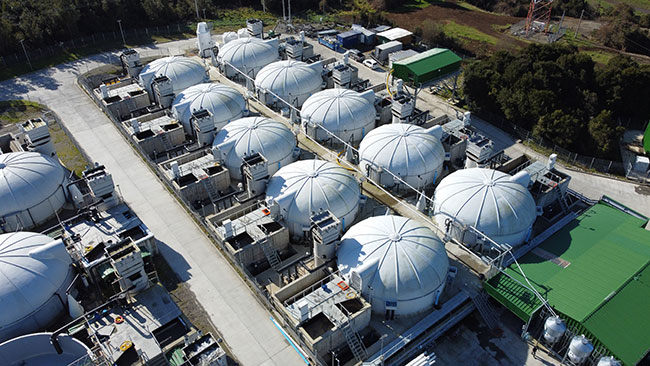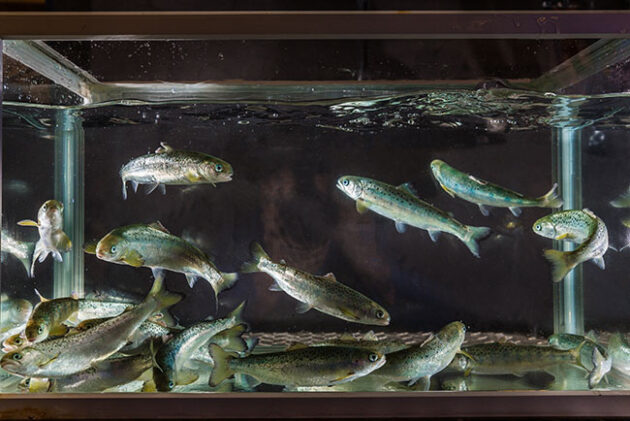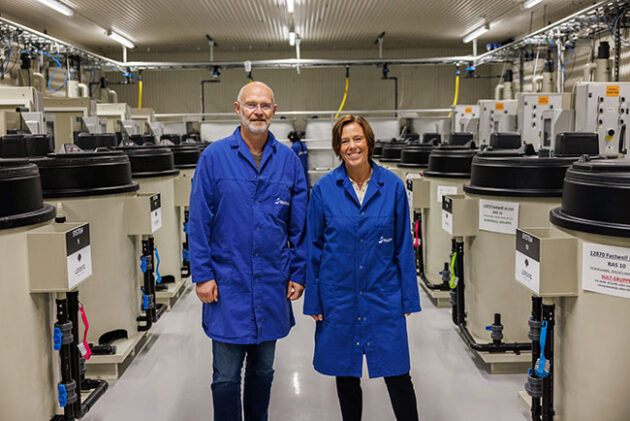
Features
post-smolt
Technology
To smolt or not
Is smolt and post-smolt RAS the answer to production efficiency?
June 5, 2023 By Matt Jones
 An aerial shot of Lago Sofia’s post-smolt Atlantic salmon RAS facility in Chinquihe, Chile.
An aerial shot of Lago Sofia’s post-smolt Atlantic salmon RAS facility in Chinquihe, Chile. Post-smolt growing has been intrinsically tried to the development of recirculating aquaculture systems (RAS).
In the past decade, post-smolt growing efforts have become increasingly popular among aquaculture practitioners. For the uninitiated, post-smolt growing refers to keeping young fish in RAS for longer before transferring them into open-net sea pens to continue their maturation. This technique is intended to have the benefit of allowing the fish to become larger, heartier, and more resilient to diseases and other impacts they could experience in the net-pens.
In just the past year alone, there have been multiple examples. Norway’s Aker purchased 25.3 per cent of Gaia Salmon, which looks to produce around 7,200 tonnes of salmon per year at a new post-smolt facility. After being delayed by the COVID-19 pandemic, Grieg Seafood’s plans to build a large post-smolt facility in Newfoundland, Canada appear to be back on track. And in New Brunswick, Cooke Aquaculture was approved to develop a C$72 million (US$53.3 million) post-smolt facility.
“Hybrid systems, involving a mix of land and marine-based fish farming will continue to be part of our future,” said Cooke Aquaculture vice-president of public relations, Joel Richardson, in a news release. “Innovative scientific technologies bring a new opportunity for greater production in ocean waters by shortening time Atlantic salmon spend in marine cages.”
RAStech Magazine spoke with several researchers and practitioners to find out more about why the technique is becoming increasingly popular and what benefits the producers have seen.
A GRADUAL DEVELOPMENT
More than 20 years ago, in the early days of the Chilean salmon industry, RAS systems were developed after the country’s environmental regulators would not permit flowthrough systems.
In 2011, the Norwegian aquaculture industry also started to adopt the technology after a regulatory change. In the decade that followed, the industry became more profitable, and the Norwegian companies started using some of those profits to build post-smolt facilities.
“In Norway, the regulations are such that if you can speed up sea pen cycles, you can start (your production cycle) all over again. Over the course of several years, you’ll achieve more production,” says Matt Craze, founder and head researcher at Spheric Research. “You can’t do that in Chile because there’s a calendar system for stocking fish.”
Craze publishes an annual “Land-Based Aquaculture Report” that provides a detailed data analysis on the development in land-based projects around the world. The report collects data from about 190 projects from around the world, plus a database on 100 post-smolt facilities.
“In Norway, there’s a very significant advantage to adopting a post-smolt strategy,” Craze explained. “And then when you think of the sea lice problem in Norway, especially in southern Norway, taking fish up to say 500 grams will allow you to avoid having the fish in the waters for two summers and therefore, you don’t have to apply as many treatments and you don’t have to handle the fish as much.”
Åsa Maria O. Espmark is a senior scientist and RAS expert at the Norwegian Institute of Food, Fisheries and Aquaculture Research, also known as Nofima. She adds that Norway is intending to grow their aquaculture production dramatically over the next 20-30 years, but the consensus seems to be that it cannot happen in open water.
“If they’re going to grow, then the growth needs to be somewhere else in different systems,” says Espmark. “And that is where the semi-closed system comes in, which I think has huge potential.”
All of which explains why the technique gained traction in Norway and Chile, but why has it proliferated to other parts of the world? Craze posits that it has to do with the variety of biological challenges faced across the world.
“In Eastern Canada, you’re dealing with quite cold water, especially in the winter months. It allows these farmers to take more control of the biological parameters of the fish into a later stage,” says Craze. “It’s part of a strategy of growing fish in very challenging environments, whether it’s been disease issues, temperature variation, it’s basically taking the risk of these fish being out at sea into their own hands and having more control.”

Post-smolt Atlantic salmon in a research tank at Nofima
Photos: Terje Aamodt, Nofima
WHAT ARE THE BENEFITS?
Water temperature control has also been a big benefit for northern European countries, says John Davidson, research scientist at the Freshwater Institute.
“My understanding is that (Norway) has had a history of increased mortalities when they transfer the fish from their land-based systems to their sea cages,” he says. “So by growing larger smolt, the understanding is that those fish are more robust, less likely to succumb to the change of environment and less likely to be affected by sea lice.”
Miguel Portus, CEO of Lago Sofia in Chile, says that their company is 100 per cent dedicated to providing quality smolt for its customers and made investments into infrastructure, technology, monitoring, and control due to a belief that the industry should go for bigger, stronger and more robust smolts. The technology, he says, has been perfected over the last decade, making it very attractive due to biosecurity and flexibility.
“The smoltification stage has been brought closer to sea sites, significantly reducing handling and movements, lowering freight costs and above all improving the sanitary condition of the fish, making each batch safer and more robust to face sanitary challenges from sea,” says Portus. “Lago Sofia facilities have permits and spaces available to grow and increase production on land.”
Davison’s prior word choice – “the understanding” – should be noted, however. While many have touted the benefits of post-smolt growing as it relates to fish health, it has yet to be proven by research. In fact, Craze notes that some scientists in Norway have claimed that the fish actually do better in older flowthrough systems in colder water. But regardless of that aspect, having the fish in the water for less time is advantageous for many other reasons.
“There’s different viewpoints out there,” says Craze. “But we’ve run analysis on a company like Lerøy (Seafood), that was having pretty significant difficulties in its farms in southern Norway. And they made themselves completely self-sufficient with very large smolt coming from very modern RAS facilities. They did seem to hit a slight production bump when these things come online, but not much. It may just be that they’re offsetting potential declines in population as the sea lice problem gets worse.”
Espmark says, however, that as much as these systems have developed significantly in the past, they may evolve to the point where they could have more wide-ranging benefits in the future.
“At the moment, they don’t prevent some other diseases, but the systems are quite new, only 10 or 15 years,” she says. “We’re working on ways to make water treatments and effluent treatments cheaper to make them more suitable for people to use.”

Nofima researchers Per Brunsvik and Åsa Espmark at the Sunndalsøra facility
Photos: Terje Aamodt, Nofima
GROWING THE FUTURE
While there are so many benefits, it may be tempting to label post-smolt growing as the future of the industry. However, as Portus notes, the future of the industry will most likely not be defined by any one specific technique, even if post-smolt growing will present a very useful solution to a variety of environmental and regulatory challenges in certain markets.
“The production of fish to harvest in (land-based systems) is a very ambitious objective for many companies, great steps have been taken through innovation and technology,” say Portus. “There are experiences that have been more successful than others but without a doubt they already mark a path towards the implementation of these technologies in the short term.”
Portus also sees bringing production closer to destination markets and contributing to an abundant local market is a good way to reduce emissions, bring consumers closer and to reduce logistic effort.
Espmark also agrees that post-smolt rearing will likely remain just one of the many tools in the aquaculturist’s toolbox, rather than the new standard. It’s most likely use case will be determined by factors such as geography, water temperature, water access, numbers of sea lice and other issues.
“This variation will continue for a long time because I think that most farmers find their own way to do things,” says Espmark. “I’m not 100 per cent sure how widespread it will be to just keep on post-smolt because there are so many unanswered questions. In Norway, you have the hypothesis that this would improve the welfare of the fish – and it still may do that, but there are so many unanswered questions of how to do it correctly that I’m unsure what will happen when we have all the answers.”
For aquaculture practitioners who are interested in exploring the possibility of incorporating a post-smolt aspect to their operations, Espmark recommends reaching out to institutes such as Nofima or the Freshwater Institute.
Davidson says that the technical know-how to work with post-smolt facilities is mostly an extension of the knowledge that the producers already have. The biggest salmon farmers are already using RAS systems at least to some degree, but there are several questions that should be asked before barreling forward.
“I think if you were to change your approach, you would certainly have to have a different bio plan or different engineering design that supported more production on land, so that would be a pretty big shift,” says Davidson. “To grow larger smolts on land will require more tanks, potentially more water, which RAS can help with by conserving water. If you’re just starting from scratch and don’t have any experience with RAS, that’s a different story. Moving from flowthrough to RAS is a big change in terms of understanding the technology and how to operate it and how to benefit from that technology.”
Print this page